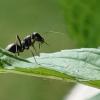1. Location (on a map) of collection: Paintsville, Kentucky
2. Date of collection: 6/24/19 5:00PM
3. Habitat of collection: Low Elevation mountain area near blackberry and high shrub area.
4. Length (from head to gaster): 11 mm
5. Color, hue, pattern and texture: Red to Dark Brown very shiny. Seems to be a lighter hue in sunlight.
6. Distinguishing characteristics: N/A
7. Distinguishing behavior: N/A
8. Nest description: N/A
9. Nuptial flight time and date: Didn't see the flight, but collected the queen at around 5PM. Did not see any others.
I think its Formcia pallidefulva, but I've never tried identifying Formica species.



















